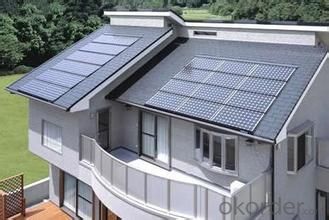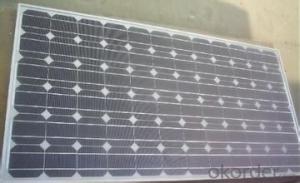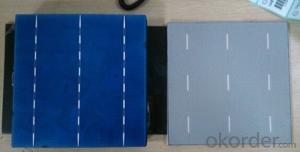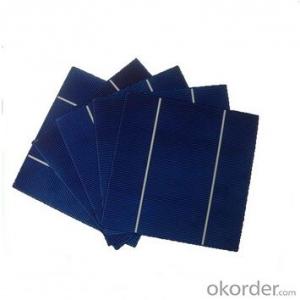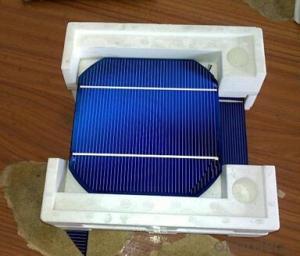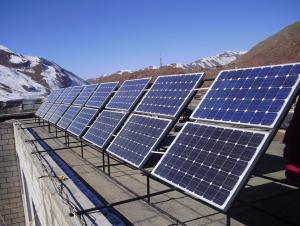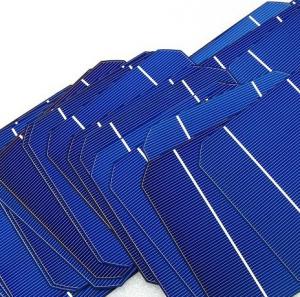Monocrystalline Silicon Solar Cell 156mm 2024
- Loading Port:
- China Main Port
- Payment Terms:
- TT OR LC
- Min Order Qty:
- -
- Supply Capability:
- -
OKorder Service Pledge
OKorder Financial Service
You Might Also Like
Quick Details
| Model Number: | |||||
| Material: | Size: | Number of Cells: | |||
| Max. Power: | Weight: | Rating Power (Pm): | |||
| Tolerance: | Rated Voltage (Vm): | Rated Current (Im): | |||
| Open Circuit Voltage (Voc): | Short Circuit Voltage (Isc): | Size of cells: | |||
| Website: |
Packaging & Delivery
| Packaging Detail: | Standard export packing |
| Delivery Detail: | 20days |
Specifications
1)High quality monocrystalline silicon solar cell
2) Competitive prices
3) TUV, UL, IEC61215,IEC61730, CE
monocrystalline silicon solar cell
1,Solar Module is widely used for
1)Microwave/radio repeater stations,
2)Electrification of villages in emote areas,
3)Medical facilities in rural areas,
4)Power source for summer vacation homes,
5)Emergency communication systems
6)Water quality and environmental data monitoring systems
7)Navigation lighthouses, and ocean buoys
8)Pumping systems for irrigation, rural water supplies and livestock watering
9)Aviation obstruction lights
10)Cathodic protection systems
11)Desalination systems
12)Recreational vehicles
13)Railroad signals
14)Sailboat charging systems
2) Product Description
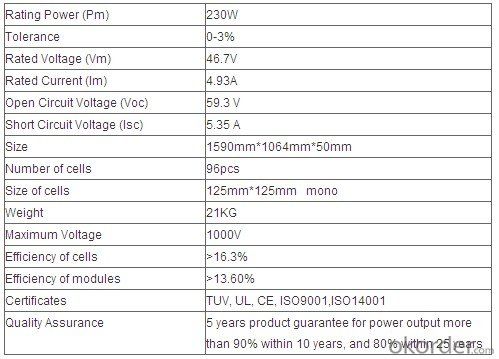
- Q: What is the impact of solar cells on reducing energy waste?
- Solar cells have a significant impact on reducing energy waste by harnessing the sun's energy and converting it into electricity. By utilizing renewable and clean energy sources, solar cells contribute to reducing the dependence on fossil fuels, which are finite and contribute to environmental pollution. Additionally, solar cells help decrease energy waste by generating electricity at the point of use, minimizing transmission and distribution losses.
- Q: What is the impact of electromagnetic interference on solar cell performance?
- Electromagnetic interference can have a significant impact on solar cell performance. It can disrupt the flow of electrons within the solar cell, leading to reduced efficiency and power output. This interference can be caused by various sources such as power lines, radio waves, or nearby electronic devices. To mitigate its effects, proper shielding and grounding techniques need to be implemented to minimize electromagnetic interference and maximize the performance of solar cells.
- Q: What is a polycrystalline solar cell?
- A polycrystalline solar cell is a type of solar cell made from multiple crystal structures, resulting in a grainy appearance. It is less expensive to produce compared to monocrystalline cells, but typically has lower efficiency levels.
- Q: What is the effect of shading on solar cell performance?
- Shading has a significant negative effect on solar cell performance as it reduces the amount of sunlight reaching the cell, leading to decreased energy production. Even a small shaded area can cause a significant drop in efficiency, as solar cells are interconnected and operate in series. The shaded portion acts as a barrier, limiting the flow of current and reducing overall power output. Therefore, it is crucial to minimize shading to maximize the performance and efficiency of solar cells.
- Q: Solar panel resistance is changed with what
- the main elements involved in the battery, the internal electrode wire, as well as external links cable. These elements have a common characteristic, that is, at low temperatures, the resistance value will all become smaller, so the conclusion is: in the same radiation intensity,
- Q: Can solar cells be used in smart home automation systems?
- Yes, solar cells can be used in smart home automation systems. Solar cells are used to convert sunlight into electricity, which can then be used to power various devices and systems in a smart home. By integrating solar cells into a smart home automation system, homeowners can reduce their reliance on traditional electricity sources and take advantage of renewable energy, leading to energy efficiency and cost savings. Additionally, solar-powered smart home automation systems can contribute to a more sustainable and environmentally friendly lifestyle.
- Q: How do solar cells handle temperature fluctuations?
- Solar cells are designed to handle temperature fluctuations by incorporating materials that can withstand high temperatures. They are also equipped with cooling mechanisms to dissipate excess heat and maintain optimal operating temperatures. Additionally, solar cells are designed to minimize the impact of temperature changes on their performance by employing temperature coefficients that adjust the electrical output accordingly.
- Q: Can somebody list some of the materials used for making solar cells?
- Solar cells are typically named after the semiconducting material they are made of.
- Q: How can I understand the working principles of solar cells?
- My way of understand the working principles of solar cells is to read tons of books about that topic.
- Q: Are there any library or exhibition halls where I can show students at school how the solar cells works?
- Why don't you arrange a tour to the solar cell library in downtown?
Send your message to us
Monocrystalline Silicon Solar Cell 156mm 2024
- Loading Port:
- China Main Port
- Payment Terms:
- TT OR LC
- Min Order Qty:
- -
- Supply Capability:
- -
OKorder Service Pledge
OKorder Financial Service
Similar products
Hot products
Hot Searches
Related keywords

